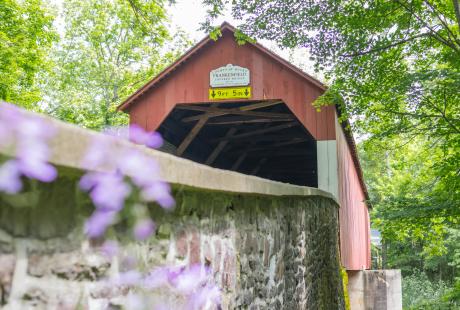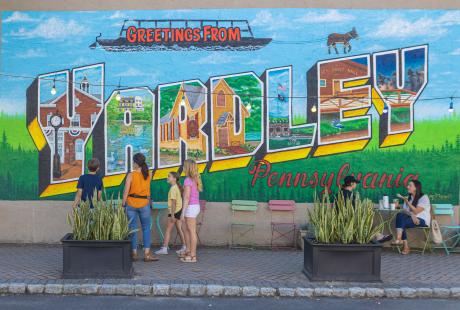Quaker Meetinghouse Driving Tour
The Quaker religion is synonymous with Pennsylvania, as it was a Quaker, William Penn, who founded it. Their places of worship, called “meetinghouses,” are unique in their stone and concrete architecture. There are at least a dozen Quaker meetinghouses located throughout Bucks County. These historic structures date back to the 1700s. All are still in use by Quakers for religious services today!
Visit these astounding buildings on your own. To conquer the whole tour, starting up in Plumstead and heading all the way to Bristol will take you most of the day. Most of the meetinghouses are public and are fine with visitors stopping to admire and take a quick photo. Follow along and read about each house below on your stop! Tag us @VisitBucksPA and #ExploreinBucksCo with your photos on social media.
1. PLUMSTEAD FRIENDS MEETINGHOUSE
4914-A, 4914 Point Pleasant Pike, Doylestown, PA 18902
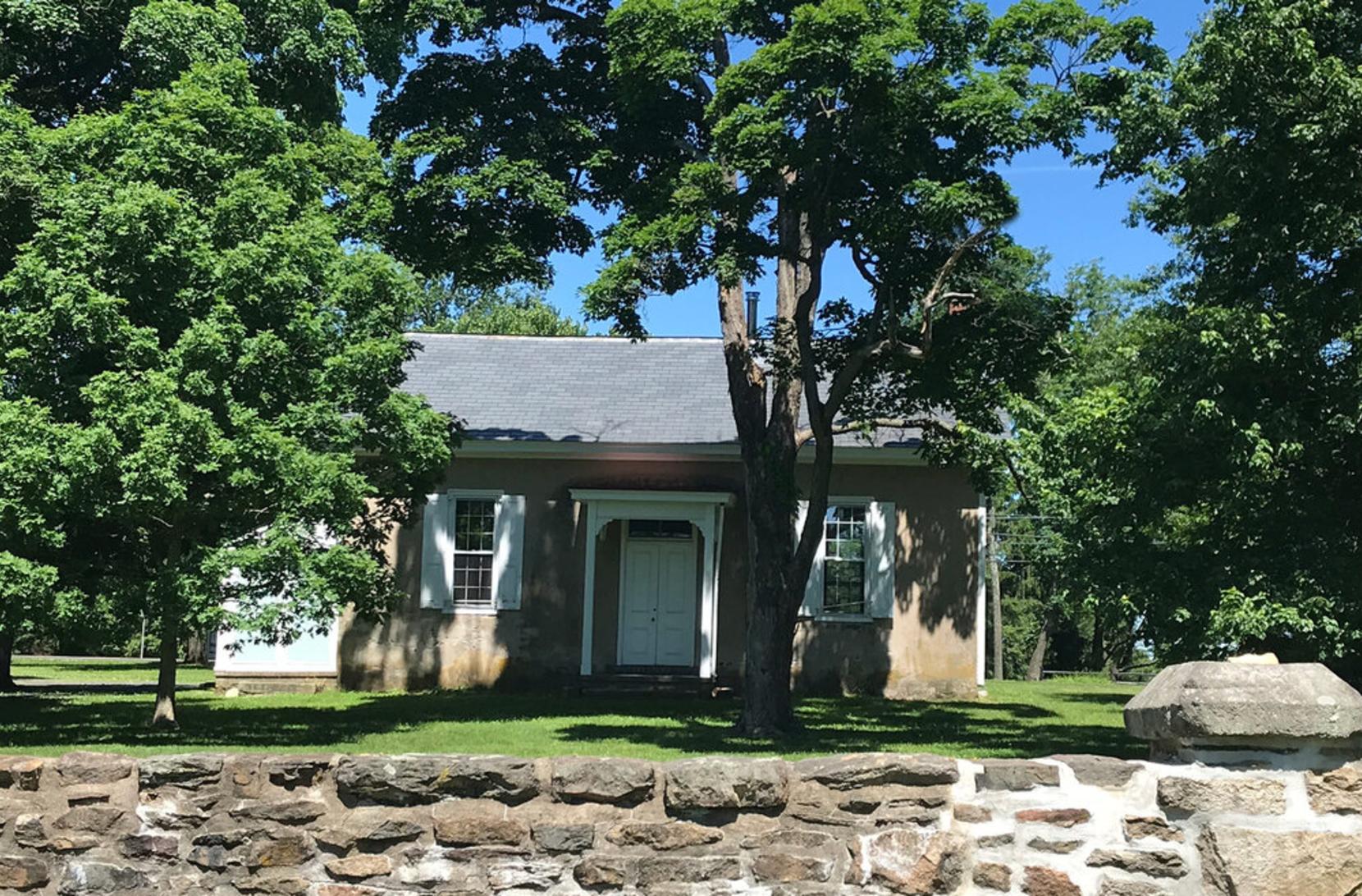
- PLUMSTEAD FRIENDS MEETINGHOUSE
The first meetinghouse in Plumstead was erected in 1730 on 15 acres of donated land. This log cabin stood until 1752, when it was replaced by a new stone meetinghouse, built with stone taken from a small quarry on the property. The present walled, one-acre burial ground was also established then. The current meetinghouse was re-built in 1875 at a cost of $1308.13. Its architectural style is of the early single cell cottage types. It is the only meetinghouse in Bucks County that does not have electricity or plumbing. Heat in the winter is provided by a centrally located wood-burning stove and there is a small privy located at the front of the building. A historical marker was erected on the property, which describes the Doan Gang, who robbed the County treasury in 1781. Three members of the gang are thought to be buried nearby!
2. DOYLESTOWN FRIENDS MEETINGHOUSE
95 E Oakland Ave, Doylestown, PA 18901

- DOYLESTOWN FRIENDS MEETINGHOUSE
Doylestown Friends Meetinghouse is a red brick building erected in 1835 on a small lot in Doylestown Borough, with little room for future expansion. The building was originally a one-story 50’ x 26’ structure, which is small compared to other meetinghouses in Bucks County. Total cost of the building was $1654.50, which was significantly more than the cost to build other meetinghouses in the area. Over the next 100 years, membership dwindled to just a handful of worshippers until the mid-1940s when a small group of dedicated Friends worked to revive membership. Because of this growth, an ambitious remodeling project was undertaken in 1955 to expand their square footage by hand-excavating the cellar for classrooms and a kitchen. Architecturally, the meeting house looks virtually the same as it did in 1835.
3. BUCKINGHAM FRIENDS MEETINGHOUSE
5684 York Road, (Routes 202 - 263), Lahaska, PA 18931
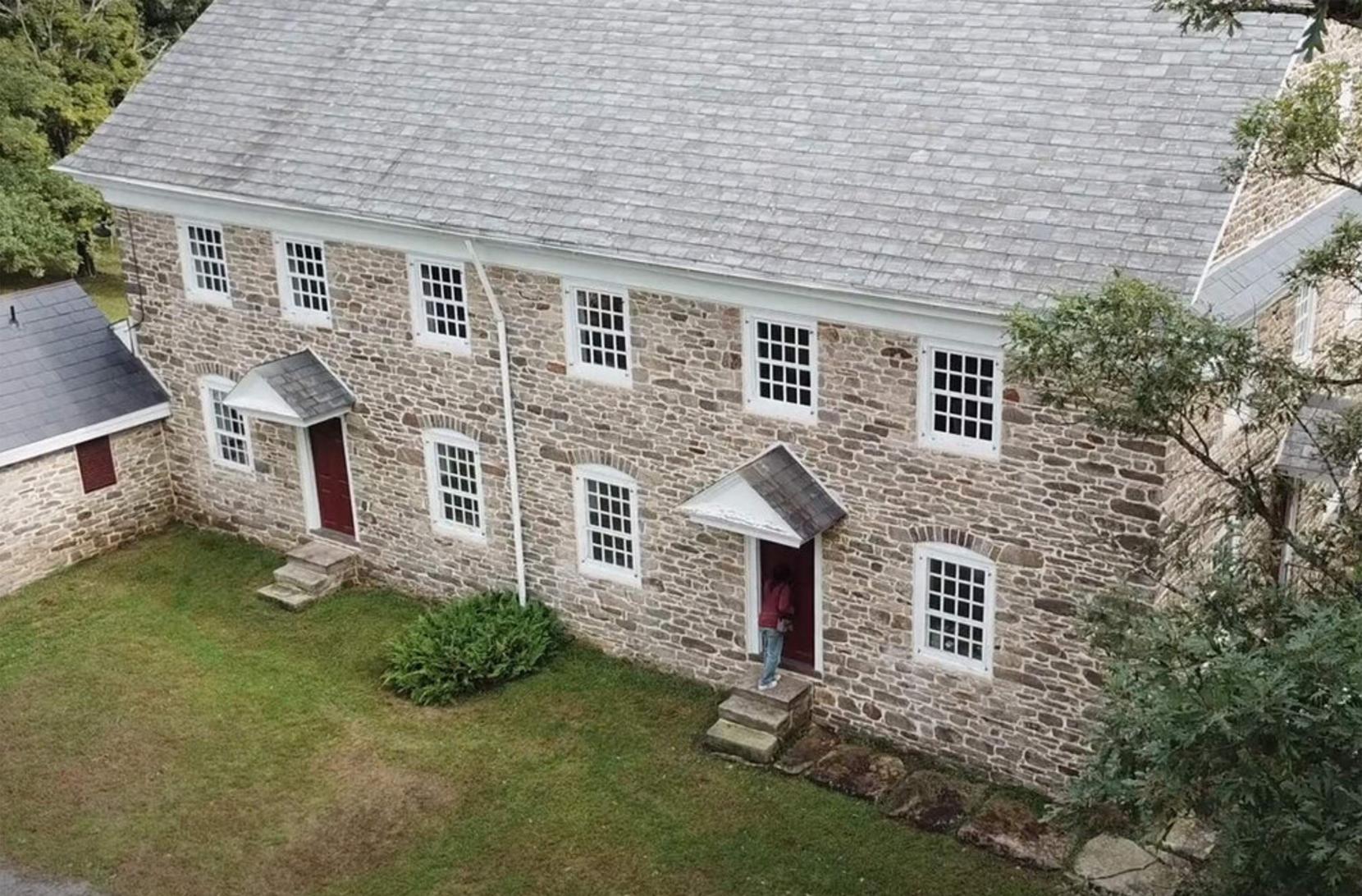
- Buckingham Friends Meeting House
The current meetinghouse – the fourth on the property – was built in 1768 at a cost 736 pounds. At that time, York Road (Rt. 202) ran along the north side of the building, close to the present graveyard wall, and the meetinghouse was built facing away from the road, to make southern facing entrances as most meetinghouses of the time had. The road shifted to the south sometime after the American Revolution. A 1768 datestone can be found in the east gable. Behind the meetinghouse to the north stand two sheds formerly used to shelter worshipers’ horses during the service. The burial ground has been in continuous use since about 1705. When the meetinghouse was requisitioned as an army hospital during the Revolutionary War, soldiers were buried either in the graveyard or nearby, and an area in the graveyard was set aside for the burial of African Americans in the early 19th century. There are also several Native American graves in the burial grounds. The earliest gravestones are dated in the 1790s, as Quakers did not use grave markers at first. Today there are about 2,500 gravestones. The meetinghouse was designated a National Historic Landmark in 2003.
4. SOLEBURY FRIENDS MEETINGHOUSE
2680 Sugan Rd, New Hope, PA 18938

- SOLEBURY FRIENDS MEETINGHOUSE
The Solebury Friends Meetinghouse was built during the summer and fall of 1806 by members who were skilled in the use of local stone and timber. The land was purchased from Aaron Paxson, Sr., which can be traced back to an original land grant from William Penn to Joseph Pike in 1705. To the east of the building is the stone First Day School building, which was originally a shed for tying horses. It was converted to its present configuration in 1931. A well-kept and active burial ground is located directly across the street. In 1997, Solebury Meetinghouse was added to the Local Register of Historic Places.
5. WRIGHTSTOWN FRIENDS MEETINGHOUSE
535 Durham Road, Newtown, PA 18940

- WRIGHTSTOWN FRIENDS MEETINGHOUSE
The first Wrightstown Friends Meetinghouse was a log structure built in 1721 on four acres of land donated by the sons of John Chapman, Wrightstown’s first settler, who came to America in 1684. In 1735, an upper story was added. Two years later a one-story addition of local shale stone was built on its north side. To meet the needs of the growing community, the current meetinghouse was erected between 1787 and 1789, using the stone walls of the 1737 addition. Made of local shale stone, the building measures 40’ x 65’. The yellow-tinged stucco is thought to have been used to hide the fact that the stonework was done at different times by different masons. Burials in the graveyard began in 1721. It is a well-maintained and active graveyard, containing more than 3,700 burials. There is a historical marker erected on the grounds identifying the starting point of the 1737 Walking Purchase. The meetinghouse was added to the National Register of Historic Places in 1975.
6. MAKEFIELD FRIENDS MEETINGHOUSE
877 Dolington Rd, Newtown, PA 18940

- MAKEFIELD FRIENDS MEETINGHOUSE
Makefield Friends Meetinghouse is a two-story, gable-roofed structure of stucco over stone constructions built on one acre, eighteen perches of land donated by Thomas Harvey. The meetinghouse has been in use continuously as a house of worship since it was built in 1752. On the grounds are sheds constructed around the year1800 for the benefit of the numerous worshippers who arrived on horseback. Originally, the sheds stood to the west of the meetinghouse but were moved to their present location in 1858. They were fully restored in 1971. Behind the meetinghouse is a burial ground that is shared with Yardley Friends Meeting. Large grassy areas contain graves, but no headstones, as headstones were not regularly used in Quaker graveyards until the early 1850s. In front of the meetinghouse, there is a peace pole that was dedicated in 2018, and the Penn Treaty Elm, located in the circular area west of the meetinghouse, which was planted in 2020. Makefield Friends Meetinghouse is believed to be the oldest church in the area. Many who attended the meeting were prominent in local political and economic affairs, and the meetinghouse was reportedly used as a hospital during the American Revolution. It was added to the National Register of Historic Places in 1974.
7. YARDLEY FRIENDS MEETINGHOUSE
65 N Main St, Yardley, PA 19067

- YARDLEY FRIENDS MEETINGHOUSE
In the early 1950s with their growing membership creating overcrowding in their small meetinghouse, Yardley Quakers were gifted a plot by the Cadwallader family for the purpose of building a new larger meetinghouse. The land is about six acres bordering Afton Lake in the middle of the Yardley Borough next to a dam with a waterfall that contributes the sound of rushing water in Buck Creek all year long. The architect chosen was H. Mather Lippincott, an experienced Quaker architect. The building was projected to cost not more than $45,000 and their outgrown building was sold to the Yardley Savings and Loan Association to help defray the costs. Construction began in January 1956. The work was completed by a series of professional contractors with meeting members adding their sweat equity where they were able. The building was completed in November of that same year. The current meeting house is a blend of traditional simplicity and modern convenience. It is a long, one-story rectangular building, constructed from locally quarried stone, set with small-paned windows with a large covered front porch. The most recent addition is a walking labyrinth located behind the meetinghouse; it is open to the public.
8. NEWTOWN FRIENDS MEETINGHOUSE
219 Court St, Newtown, PA 18940

- NEWTOWN FRIENDS MEETINGHOUSE
The original portion of the meetinghouse, constructed in 1817, consists of a two-story 40’ x 60’ stone stucco structure with a gable roof built on a lot two acres and 85 perches, which was purchased from Dr. Phineas Jenks for $460. The plan of the meetinghouse is like other Friends’ meetinghouses of the time with six pairs of exterior doors with orientation of one long side of the building toward the south. All the windows have paneled shutters, most with their original hardware. The first addition on the property was horse sheds built north of the meetinghouse in 1819 for the protection of the members’ horses during meetings. The first recorded alteration to the meetinghouse was the addition of a south portico with stone flagging in 1868. An addition was added on the east side in the 1950s and was replaced in 2005 with the current addition. A peace garden and peace pole and benches were added more recently. South and east of the meetinghouse is the burial ground. The first burial was in 1820, but the location is unknown. Among the approximately 600 burials is Edward Hicks, American folk artist and Quaker minister, who is buried under the large Sycamore tree.
9. FRIENDS MEETING OF SOUTHAMPTON
710 Gravel Hill Rd, Southampton, PA 18966

- FRIENDS MEETING OF SOUTHAMPTON
In 1941, the Southampton Friends began to worship in homes at the Bryn Gweled Homesteads, an intentional community that was being developed. In 1947, they cleaned and renovated a previous structure on the current property – an old one-room school that was later converted into a taproom. The adjacent “House on the Hill” was acquired in 1960. The current meetinghouse was designed by architect Bert Klett and erected by contractor E. Allen Reeves. It was built between 1969 and 1970 and is the most recently constructed Friends' meetinghouse in Bucks County. Its ultra-modern design reflects a break in tradition regarding both exterior appearance and interior plan. The meeting room has a large picture window with a view to the scenic woods.
10. MIDDLETOWN FRIENDS MEETINGHOUSE
453 W Maple Ave, Langhorne, PA 19047

- MIDDLETOWN FRIENDS MEETINGHOUSE
The current meetinghouse, built in 1793, can trace its lineage back to the 17th century. The first meetinghouse was erected in 1688, somewhere near the Neshaminy, on land given by Nicholas Waln, a wealthy Philadelphia merchant. The small log meetinghouse soon proved to be inadequate as the Quaker population in Bucks County continued to grow and a new larger meetinghouse, located on the present tract, was built in 1721. In 1690, land behind the meetinghouse was designated as a burial ground. A stone fence was erected around the perimeter in 1734. In 2018, a Memorial for the Forgotten Slaves was erected to recognize the enslaved people, owned by members of Middletown Meeting, who died and were buried in the graveyard between 1693 and 1703.
11. FALLSINGTON FRIENDS MEETINGHOUSE
9300 New Falls Rd, Levittown, PA 19054

- FALLSINGTON FRIENDS MEETINGHOUSE
Fallsington Friends built their first Meetinghouse, a 20' x 25' wooden structure, in 1690 on six acres of land given by Samuel Burges. It was here that Governor William Penn worshiped, travelling from Pennsbury Manor, his home on the Delaware River. By 1728 the congregation had outgrown the 1690 Meetinghouse, and erected a larger stone building, now a residence viewed on Meetinghouse Square in the center of the historic village of Fallsington. A third meetinghouse built in 1789 now houses the William Penn Center. A fourth meetinghouse dates from 1841, with a 1990 addition, and is the current home for Fallsington Quakers. Surrounding the meetinghouses are three graveyards, the earliest established in 1692. A carriage shed still exists, as well as a horse mounting block. The village of Fallsington retains much of its colonial character and is a beautiful place for a walking tour!
12. BRISTOL FRIENDS MEETINGHOUSE
235 Market St, Bristol, PA 19007
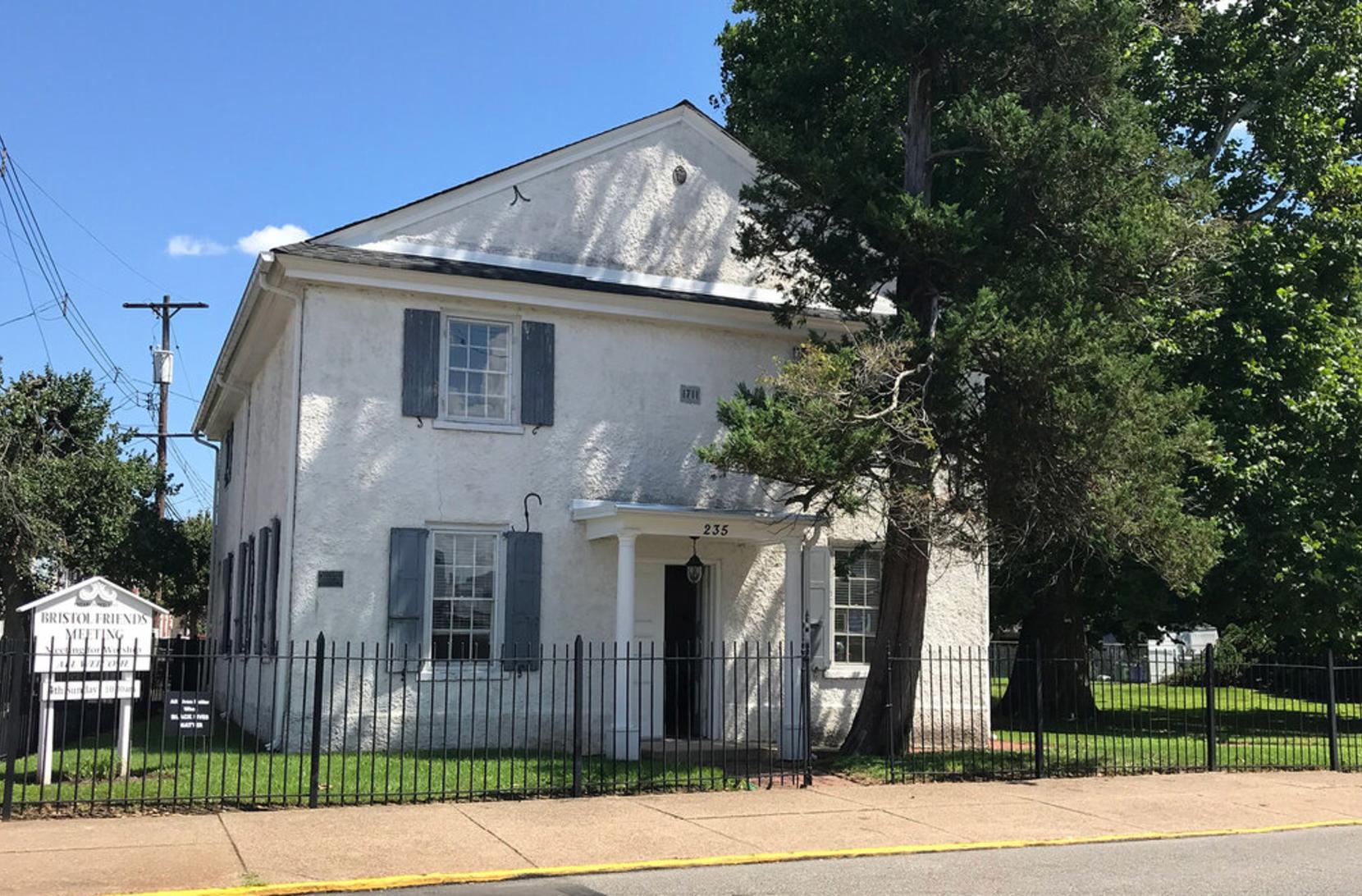
- BRISTOL FRIENDS MEETINGHOUSE
In 1701, Bristol Quakers began meeting in in various homes until Samuel Carpenter, a wealthy Philadelphia businessman and Quaker, donated the site at Market and Wood Streets for the purpose of erecting a one-story meetinghouse. Construction began in 1711 with a single brick brought from England, and cost 200 English pounds, or roughly about $378. The meetinghouse was enlarged in 1735, and in 1756 a second story was added. The building, which was placed on the National Register of Historic Places in 1987, has an application of stucco that covers the brick construction. A great fire destroyed most of Bristol in 1724, leaving the meetinghouse as the only surviving building from Bristol’s initial period of development. Fun fact, the large buttonwood tree in the yard pre-dates William Penn’s arrival in Pennsylvania.

